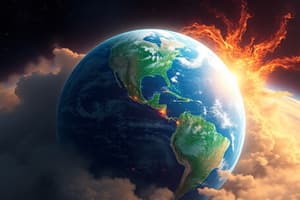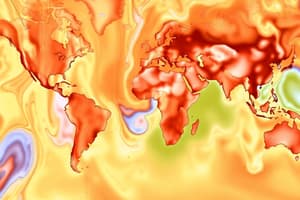Podcast
Questions and Answers
What are the two primary approaches used to estimate the Earth's temperature distribution?
What are the two primary approaches used to estimate the Earth's temperature distribution?
Models of the Earth's thermal history and models involving redistribution of radioactive heat sources.
What is the estimated temperature range at the center of the Earth's core?
What is the estimated temperature range at the center of the Earth's core?
Between 6700 to 7000 °C.
What significant temperature change occurs at the 660-km discontinuity?
What significant temperature change occurs at the 660-km discontinuity?
It marks the boundary between shallow and deep convection systems.
Who proposed the theory of seafloor spreading and in what year?
Who proposed the theory of seafloor spreading and in what year?
How does seafloor spreading contribute to the formation of new lithosphere?
How does seafloor spreading contribute to the formation of new lithosphere?
What evidence was recognized in the 1950s that helped popularize the concept of seafloor spreading?
What evidence was recognized in the 1950s that helped popularize the concept of seafloor spreading?
Describe the temperature gradient observed in the LVZ and the D'' layer.
Describe the temperature gradient observed in the LVZ and the D'' layer.
What kind of geological features can disrupt the continuity of linear magnetic anomalies?
What kind of geological features can disrupt the continuity of linear magnetic anomalies?
What effect does a submarine plateau have when it encounters a subduction zone?
What effect does a submarine plateau have when it encounters a subduction zone?
What type of earthquakes are mostly associated with the India-Asia boundary?
What type of earthquakes are mostly associated with the India-Asia boundary?
What dominates near sutures in collisional boundaries?
What dominates near sutures in collisional boundaries?
What percentage of the Earth's volume and mass does the core comprise?
What percentage of the Earth's volume and mass does the core comprise?
What geological feature is formed in response to the India collision?
What geological feature is formed in response to the India collision?
What region is known for the flattening of velocity and density gradients?
What region is known for the flattening of velocity and density gradients?
How does the volume of the accretionary prism get affected during an arc-continent collision?
How does the volume of the accretionary prism get affected during an arc-continent collision?
What is the thickness range of the lithosphere?
What is the thickness range of the lithosphere?
What kind of faulting is common in the overriding plate during the collision illustrated in the content?
What kind of faulting is common in the overriding plate during the collision illustrated in the content?
Why is the Low Velocity Zone (LVZ) important for plate tectonics?
Why is the Low Velocity Zone (LVZ) important for plate tectonics?
What happens to the landward slope of the trench in a collision zone?
What happens to the landward slope of the trench in a collision zone?
What does the outer core's inability to transmit S-waves suggest about its state?
What does the outer core's inability to transmit S-waves suggest about its state?
What important geological process does the Sunda arc system illustrate in its early stages?
What important geological process does the Sunda arc system illustrate in its early stages?
What elements influence the temperature distribution within the Earth?
What elements influence the temperature distribution within the Earth?
At what discontinuity does the inner core extend from?
At what discontinuity does the inner core extend from?
What occurs in the D'' layer that is significant to mantle dynamics?
What occurs in the D'' layer that is significant to mantle dynamics?
What is the average age of oceanic crust before it begins to subduct?
What is the average age of oceanic crust before it begins to subduct?
What geological events preceded the velocity maxima of continental plates?
What geological events preceded the velocity maxima of continental plates?
What do ophiolites represent in the context of oceanic crust?
What do ophiolites represent in the context of oceanic crust?
How do calculated seafloor spreading directions help in paleogeographic reconstructions?
How do calculated seafloor spreading directions help in paleogeographic reconstructions?
What does the average age of oceanic crust on most continents indicate about its lifecycle?
What does the average age of oceanic crust on most continents indicate about its lifecycle?
What historical evidence is shown by paleomagnetic data from Archean rocks?
What historical evidence is shown by paleomagnetic data from Archean rocks?
What illustrates the direction of plate movement in seafloor spreading reconstructions?
What illustrates the direction of plate movement in seafloor spreading reconstructions?
What significant historical tectonic event is associated with the opening of the North Atlantic?
What significant historical tectonic event is associated with the opening of the North Atlantic?
What does the term 'episodic heat transfer' refer to in the context of the lower mantle?
What does the term 'episodic heat transfer' refer to in the context of the lower mantle?
What possible implications can episodic heat loss have on the Earth's geological activity?
What possible implications can episodic heat loss have on the Earth's geological activity?
How might the heat transfer from the lower mantle be measured or observed?
How might the heat transfer from the lower mantle be measured or observed?
What factors could contribute to the episodic nature of heat loss from the mantle?
What factors could contribute to the episodic nature of heat loss from the mantle?
What are the two primary minerals responsible for rock magnetization?
What are the two primary minerals responsible for rock magnetization?
Why is it significant to understand the process of heat transfer from the lower mantle?
Why is it significant to understand the process of heat transfer from the lower mantle?
What technique must be used to identify primary magnetization in rocks?
What technique must be used to identify primary magnetization in rocks?
What does NRM stand for in paleomagnetic studies?
What does NRM stand for in paleomagnetic studies?
What is thermal remanent magnetization (TRM) and how is it acquired?
What is thermal remanent magnetization (TRM) and how is it acquired?
What range does the Curie temperature for iron oxides fall within?
What range does the Curie temperature for iron oxides fall within?
Which plate driving force is chiefly responsible for plate motion according to most models?
Which plate driving force is chiefly responsible for plate motion according to most models?
What is the impact of ocean-ridge push forces on plate movement?
What is the impact of ocean-ridge push forces on plate movement?
Explain why rock magnetization varies and does not follow simple geometric relationships.
Explain why rock magnetization varies and does not follow simple geometric relationships.
Flashcards
What is the Earth's crust?
What is the Earth's crust?
The thin, outermost layer of the Earth, composed of relatively light, rigid rock. It's thinner beneath oceans and thicker under continents.
What is the LVZ?
What is the LVZ?
The region within the Earth where seismic waves travel at anomalously low speeds. It's located at the base of the lithosphere and is crucial for plate tectonics.
What is the D'' layer?
What is the D'' layer?
The boundary layer between the Earth's mantle and core. It's characterized by steep temperature gradients and may be where mantle plumes originate.
What is the lithosphere?
What is the lithosphere?
Signup and view all the flashcards
What is the mantle?
What is the mantle?
Signup and view all the flashcards
What is the outer core?
What is the outer core?
Signup and view all the flashcards
What is the inner core?
What is the inner core?
Signup and view all the flashcards
What is plate tectonics?
What is plate tectonics?
Signup and view all the flashcards
Seafloor Spreading
Seafloor Spreading
Signup and view all the flashcards
Linear Magnetic Anomalies
Linear Magnetic Anomalies
Signup and view all the flashcards
Low Velocity Zone (LVZ)
Low Velocity Zone (LVZ)
Signup and view all the flashcards
Core-Mantle Interface
Core-Mantle Interface
Signup and view all the flashcards
Outer Core
Outer Core
Signup and view all the flashcards
660-km Discontinuity
660-km Discontinuity
Signup and view all the flashcards
Accretionary Plate Boundaries
Accretionary Plate Boundaries
Signup and view all the flashcards
Convection
Convection
Signup and view all the flashcards
Episodic Heat Transfer
Episodic Heat Transfer
Signup and view all the flashcards
Episodic Heat Loss
Episodic Heat Loss
Signup and view all the flashcards
Episodic Heat Source
Episodic Heat Source
Signup and view all the flashcards
Subduction Zone Collision with Ridges
Subduction Zone Collision with Ridges
Signup and view all the flashcards
Collisional Boundaries
Collisional Boundaries
Signup and view all the flashcards
Thrust Faulting in Collision Zones
Thrust Faulting in Collision Zones
Signup and view all the flashcards
Transcurrent Faulting in Collision Zones
Transcurrent Faulting in Collision Zones
Signup and view all the flashcards
Extensional Faulting in Collision Zones
Extensional Faulting in Collision Zones
Signup and view all the flashcards
Sunda Arc System Collision
Sunda Arc System Collision
Signup and view all the flashcards
Effects of Ridge-Trench Collision
Effects of Ridge-Trench Collision
Signup and view all the flashcards
Baikal Rift Formation
Baikal Rift Formation
Signup and view all the flashcards
What is subduction?
What is subduction?
Signup and view all the flashcards
What are the average ages of oceanic crust?
What are the average ages of oceanic crust?
Signup and view all the flashcards
Where are older oceanic crust fragments found?
Where are older oceanic crust fragments found?
Signup and view all the flashcards
How can we reconstruct past plate movements?
How can we reconstruct past plate movements?
Signup and view all the flashcards
What are 'flow lines' in plate reconstruction?
What are 'flow lines' in plate reconstruction?
Signup and view all the flashcards
What were plate speeds like in the Archean?
What were plate speeds like in the Archean?
Signup and view all the flashcards
Did continental plates always move slowly?
Did continental plates always move slowly?
Signup and view all the flashcards
What is the relationship between continental breakup and plate speed?
What is the relationship between continental breakup and plate speed?
Signup and view all the flashcards
Slab-pull force
Slab-pull force
Signup and view all the flashcards
Ocean-ridge push force
Ocean-ridge push force
Signup and view all the flashcards
Demagnetization
Demagnetization
Signup and view all the flashcards
Thermal remanent magnetization (TRM)
Thermal remanent magnetization (TRM)
Signup and view all the flashcards
Curie temperature
Curie temperature
Signup and view all the flashcards
Primary magnetization
Primary magnetization
Signup and view all the flashcards
Secondary magnetization
Secondary magnetization
Signup and view all the flashcards
Natural remanent magnetization (NRM)
Natural remanent magnetization (NRM)
Signup and view all the flashcards
Study Notes
Plate Tectonics: A Perspective
- Plate tectonics is a unifying geological model, developed in the 1970s, that explains the Earth's crust and mantle evolution.
- Plate tectonics seeks to explain various phenomena including crustal deformation, earthquake patterns, continental drift, and mid-ocean ridges.
- Two major premises of plate tectonics are: the lithosphere (outermost layer) behaves as a rigid substance sitting on the weaker asthenosphere, and the lithosphere is broken into plates that move and change shape.
- Seafloor spreading, a parental theory, proposes that new lithosphere forms at ocean ridges and moves away, like a conveyor belt.
- Scientists often view the acceptance of plate tectonics as a revolution, shifting from data collection to unifying theories.
- The Earth's crust is formed from magma produced by partial melting of the mantle.
- Continents rise through isothasy and are subjected to weathering and erosion, with materials being recycled through subduction.
- The physical and chemical properties of the crust are understood via a growing data base.
Plate Boundaries
- Earthquakes occur along plate boundaries, marking the division between plates.
- Four types of plate boundaries are identified: ocean ridges, subduction zones, transform faults, and collisional zones.
- Ocean ridges are divergent boundaries where new lithosphere forms.
- Subduction zones are convergent boundaries where one plate is forced beneath another.
- Transform faults are boundaries where plates slide past each other.
- Continental margins are of two types: active margins where subduction or transform faults coincide with continental edges, and passive margins which are found in opening ocean basins.
- Earthquakes along plate boundaries may be large or small. Large earthquakes tend to be along 'locked' segments of continental transforms and they release stress.
Seafloor Spreading
- Linear magnetic anomalies on the seafloor are explained by seafloor spreading and associated magnetic field reversals.
- These anomalies, recognized in the 1950s, have steep gradients and provide evidence for seafloor spreading.
- Vine and Matthews (1963) proposed that the anomalies result from seafloor spreading and magnetic field reversals.
- Ocean ridges are areas where new oceanic lithosphere is created.
- Seafloor spreading results in the production of new ocean floor at a rate of approximately 3.5 km²/y.
Structure of the Earth
- The Earth's internal structure is revealed by seismic waves.
- The crust, mantle, and core are differentiated by seismic discontinuities (Moho, 660-km discontinuity, core-mantle interface, inner-core/outer- core interface).
- The crust is the outermost layer, ranging from 3 km to 70 km thick.
- The lithosphere (50-300 km thick) is the strong, rigid part of the Earth's surface.
- The asthenosphere is located below the lithosphere and is a layer with low seismic wave velocities.
- The mantle extends from the Moho to the core- mantle boundary.
Plate Motions
- Plate motions are described by a pole of rotation and a spherical cycloid path.
- Relative plate motions can be calculated using magnetic anomalies, hotspot tracks, and other data.
- Plate velocities vary from 1 to 20 cm/year.
Triple Junctions
- Triple junctions are points where three plate boundaries meet.
- Different combinations of plate boundaries exist at triple junctions.
Convergent Boundaries
- Convergent boundaries are marked by earthquakes beneath arc systems.
- The seismic zone or Benioff zone dips steeply beneath arc systems.
- Earthquakes often occur at depths of 30 km or greater along these zones.
Divergent Boundaries (Ocean Ridges)
- Ocean ridges are areas of new lithosphere formation.
- Rift zones are frequently associated with shallow earthquakes.
- Rift earthquakes often occur in swarms associated with magma intrusion and extrusion.
Stress Distribution within Plates
- Stress in plates is often related to large-scale features and is influenced by the interaction of plates and mantle processes.
- Stress provinces show variations in stress orientations and magnitudes.
Paleomagnetism
- Paleomagnetism studies rock magnetization to infer past Earth's magnetic fields (directions and strengths).
- The two major problems associated with reconstruc- tion include separating multiple magnetizations in same rocks and dating these magnetizations.
Hotspots and Plumes
- Hotspots are areas of volcanic activity thought to be associated with mantle plumes.
- Hotspot tracks are trails of volcanic activity, which can help to determine plate movement directions and rates.
- Hotspots are thought to remain relatively fixed in the mantle, but this is a still-debated issue.
Studying That Suits You
Use AI to generate personalized quizzes and flashcards to suit your learning preferences.
Related Documents
Description
Test your knowledge on the internal structure of the Earth with this quiz covering temperature distribution, seismic activities, and geological theories like seafloor spreading. Explore key concepts including the Earth's core temperature, significant discontinuities, and geological features formed by tectonic interactions.




